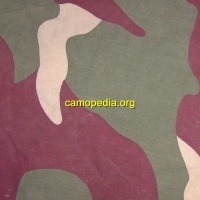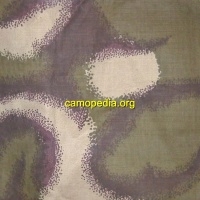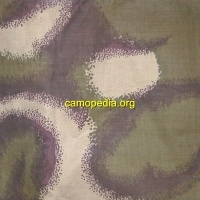Camouflage pattern M38 (Hungary)
Regarding the country known as Hungary, it has the privilege of being one of the few modern states that developed its own camouflage pattern during the Second World War. Hungary's first model was introduced as early as 1938 (the name M38 is no coincidence) and it was a camouflage pattern used practically everywhere: for painting artillery, vehicles, all technical equipment, as well as individual poncho-like garments with which the local army members were equipped. Incidentally, there were also speculations that this Hungarian camouflage pattern was based on its Italian variant well-known as "Italian M1929," but regardless of the truth, this camouflage was used during the Second World War by all Hungarian military personnel (we remind you, these were times when Hungary was a member of the well-known Axis).

Hungarian Camouflage Pattern M1938 or, in its full name: 1938 M háromszínü sátorlap-esögallér.
As post-war time passed, during the communist period (1947 – 1989), many of today's Hungarian camouflage patterns emerged. This was despite the fact that wartime items were still worn and continued to influence the colors of a substantial volume of more modern camouflage patterns (some even around the year 1980).
The standardized camouflage pattern for all regular uniforms (influenced by other camouflage used in 1949) was adopted in Hungary as the main one for all of the Hungarian army and any of its armed forces even as late as 1990. However, by this time, Hungary was slowly becoming a member of NATO (like many other countries in Central Europe). We remind you that now Hungary is a member of both NATO and the European Union. It also appeared on peace missions in Afghanistan (OEF) and with the United Nations (for which it was necessary to develop and use something suitable for the desert).
What does the M38 camouflage pattern look like?
The very first camouflage pattern developed by Hungary is called "M38" or also "1938 M" or even "M1938." This is a three-color design consisting of three color shades (khaki background + dark red-brown and olive). Its inspiration by the Italian camouflage pattern known under the designation “M1929 telo mimetico” is truly more than evident. Officially, this camouflage was produced only as a combination of tent/shelter tarps/ponchos during the second half of the Second World War. It also led to private production (i.e., by ordinary tailors) of helmet covers and raincoats, or even some hooded items for paratroopers in the German style and cut. However, over time, the practical deployment of the M1938 camouflage pattern gradually diminished and by around 1949, it completely faded away.

Hungarian Camouflage Pattern M1938, fully named: 1938 M háromszínü sátorlap-esögallér in the borderless version, which was used minimally for vehicles during the war, but possibly also for buildings.
What does the "borderless" M38 camouflage pattern look like?
Over the years, Hungary also saw a camouflage peculiarity – it’s one variation of the M38 camouflage pattern with "soft" and gentle edges. It has been documented mainly on military vehicles and some believe it was also found on buildings. However, it is generally agreed upon that its use completely ceased after the war.

Hungarian Camouflage Pattern M1938 or, in its full name: 1938 M háromszínü sátorlap-esögallér in the commercial modern version and therefore unmistakably new. It appears in this form even among modern commercial items and is also quite popular with people reenacting modern historical battles.
What does the "modern" M38 camouflage pattern look like?
Regarding the M38 camouflage pattern, there is also a modern version (hand-printed) that appeared on the modern market around the year 2005.
Image caption: “Hungarian Camouflage Pattern M1938 or, in its full name: 1938 M háromszínü sátorlap-esögallér in the commercial modern version and therefore unmistakably new. It appears in this form even among modern commercial items and is also quite popular with people reenacting modern historical battles.”




























































































































